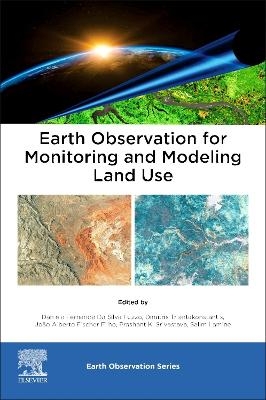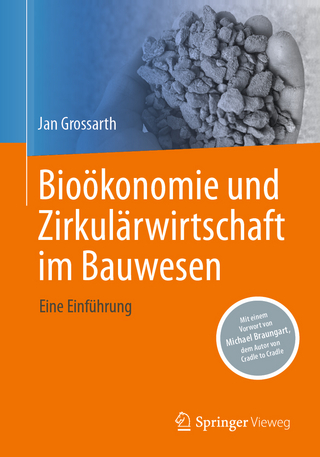
Earth Observation for Monitoring and Modeling Land Use
Elsevier - Health Sciences Division (Verlag)
978-0-323-95193-7 (ISBN)
- Noch nicht erschienen (ca. November 2024)
- Versandkostenfrei
- Auch auf Rechnung
- Artikel merken
The book spatializes the understanding of monitoring land cover and use, and quantifies the challenges faced, allowing analysis of the dynamics of the territory in terms of occupation processes, land use, and its transformations. It focuses on practical applications of using remote sensing and modeling that support new research in relation to monitoring of land use and spectral modelling, elucidating the importance of advanced methodologies in the coverage and use mappings of the Earth.
Daniela Fernanda da Silva Fuzzo graduated in Geography from Universidade Estadual Paulista Júlio de Mesquita Filho (2008) and obtained her master's degree in Agronomy (Tropical and subtropical agriculture - Management of agri-environmental resources) from Instituto Agronômico de Campinas (2011). She holds a PhD in Agricultural Engineering from the State University of Campinas (2015). She is currently a PhD Professor at the University of the State of Minas Gerais, with experience in orbital triangle methods, agrometeorological modeling, agricultural monitoring, crop estimation, land use analysis, precipitation, evapotranspiration, remote sensing, geoprocessing, cartography and geographic information systems (including ArcGis, QGis, Envi, and IDL) and is deputy coordinator of the research group CEDIAP-GEO (CNPq). Dimitris Triantakonstantis is a researcher in the soil science department of the Institute of Soil and Water Resources, Hellenic Agricultural Organization DIMITRA, Greece. He is an agronomist-soil scientist and Geographical Information Systems/Remote Sensing expert, having completed postgraduate studies in Environmental Management (Agricultural University of Athens) and GIS with Remote Sensing (University of Greenwich, UK). In 2006, he received his PhD in the field of geographic information systems, spatial statistics, and land use change modelling from the Agricultural University of Athens, Greece. He has undertaken postdoctoral research at Newcastle University (UK); ESF State University of New York (USA); the Foundation for Research and Technology Hellas, University of Thessaly (Greece) and the National Hellenic Research Foundation (Greece). His research interests lie in GIS and remote sensing of soil science, natural resource management and climate change mitigation and adaptation. João Alberto Fischer Filho graduated in Agronomic Engineering from the Faculty of Engineering of Ilha Solteira (2013), Master’s (2015) and Doctorate (2018) in Agronomy (Soil Science) from Universidade Estadual Paulista (UNESP). He is currently a professor at the State University of Minas Gerais, Brazil and at the Municipal Institute of Higher Education of Bebedouro Victório Cardassi, Brazil in the area of Agricultural Engineering. He is also an ad-hoc rapporteur for scientific journals, conference papers and scholarship-related processes, a member of the Brazilian Association of Agricultural Engineering (SBEA) and mainly works on the following areas: irrigated agriculture, irrigation management, and hydraulics for agricultural systems. Prashant K. Srivastava is working at IESD, Banaras Hindu University, as a faculty and was affiliated with Hydrological Sciences, NASA Goddard Space Flight Center, as research scientist on SMAP satellite soil mois ture retrieval algorithm development, instrumentation, and simulation for various applications. He received his PhD degree from the Department of Civil Engineering, University of Bristol, Bristol, United Kingdom. Prashant was the recipient of several awards such as NASA Fellowship, USA; University of Maryland Fellowship, USA; Commonwealth Fellowship, UK; Early Career Research Award (ECRA, DST, India), CSIR, as well as UGC JRF-NET (2005, 2006). He is leading a number of projects funded from reputed agencies in India as well as world. He was also a collaborator with NASA JPL on SMAP soil mois ture calibration and validation as well as Scatsat-1, NISAR, AVIRIS-NG missions of India. Prashant made more than 200+ publications in peer-reviewed journals and published 14 books with reputed publishing house such as Springer, Taylor and Francis, AGU-Wiley, and Elsevier, and several book chapters with good cita tion index. He presented his work in several conferences and workshops and is acting as a convener for the last few years in EGU, Hydroinformatics (HIC), and other conferences. He is also acting as Regional Editor Asia-Geocarto International (T & F), Associate Editor-Journal of Hydrology (Elsevier), GIScience and Remote Sensing (T & F), Remote Sensing Applications: Society and Environment (Elsevier), Sustainable Environment (T & F), Water Resources Management (Springer), Frontiers Remote Sensing, Associate Editor- Remote Sensing-MDPI, Associate Editor- Environment, Development and Sustainability (Springer), Environmental Processes (Springer), Bull of Env and Sci Res. Salim Lamine is a distinguished scientist, serving as a professor and international consultant specializing in remote sensing and precision agriculture. He earned his PhD through a collaborative program between Aberystwyth University in the United Kingdom and the University of Sciences and Technology Houari Boumediene in Algeria. His academic pursuits further extended to the University of Nottingham in the UK, where he delved into GNSS applications, and he gained valuable research experience as an assistant researcher at the University of Aberystwyth. In 2017 Dr. Lamine was honored with the prestigious International Prize for the Environment, “ECOWORLD, by the Russian Academy of Natural Sciences. He holds mas ter’s degrees from both the Mediterranean Agronomic Institute of Bari in Italy and the Mediterranean Agronomic Institute of Chania in Greece. Currently, he is serving as a member of the editorial board for the prominent Taylor & Francis journal, Geocarto International. Additionally, he extends his expertise as a valued member of the Advisory Panel for several MDPI Journals. Dr. Lamine’s research portfolio encompasses a wide range of multidisciplinary areas, including remote sensing, precision agriculture, hyperspectral imaging, drone-based data analysis, crop yield prediction, field spectroradiometry, water and soil management, agri-biosystems engineering, gis and space mapping, machine learning and SVAT models. Dr. Lamine has made substantial contribu tions to the academic realm, evidenced by over 30 peer-reviewed publications in esteemed journals and participation in more than 150 international confer ences. His scholarly influence also extends to the authorship of several book chapters. He authored a book entitled REMOTE SENSING: Multispectral & Hyperspectral Applications published in 2020.
Part I. EO datasets for land use/land cover 1. Remote observation for predicting soil moisture in integrated crop/livestock areas 2. Soil Chemical Properties using Hyperspectral Remote Sensing 3. Monitoring and modelling urban growth dynamics of Pune and Pimpri-Chinchwad City, Maharashtra, India 4. Drones in high resolution land use assessment using artificial intelligence Part II. Land use/land cover classification 5. Mapping the Soil Organic Carbon Sequestration Potential of Greece’s Agricultural Soils 6. Mapping Greece’s Salt Affected Soils Extent with the use of Machine Learning and Remote Sensing Data 7. A View of Biological Invasions at the Landscape Scale: A Case Study of Two Australian Acacia Species in Portugal 8. Land use and socioeconomic interventions in the production of urban climate: day and night thermal effects in a continental tropical city 9. Landscape Geoecology in the Feasibility of Creating Linear Parks in Urban Microbains Part III. Operational EO Tools for Monitoring and Modelling land use/land cover 10. Hyper-Spectral Remote Sensing: Potential Prospects in Water Quality Monitoring & Assessment 11. Appraisal of Spatial interpolation techniques in predicting soil organic carbon using Earth Observation datasets 12. Conservation Status of Permanent Preservation Areas and of Water in the Cabaçal River Basin, Mato Grosso State, Brazil Part IV. Looking into the Future: Challenges and Perspectives 13. Modeling and predicting future land use: application of Dyna-CLUE and Markov Chain - Cellular Automata Analysis (CA-Markov) models in a Brazilian watershed 14. Interpretation of Land Use and Land Cover Changes at Different Classification Levels: The Paranapanema River Basin - Brazil Case
| Erscheint lt. Verlag | 1.11.2024 |
|---|---|
| Reihe/Serie | Earth Observation |
| Verlagsort | Philadelphia |
| Sprache | englisch |
| Maße | 152 x 229 mm |
| Themenwelt | Naturwissenschaften ► Biologie ► Ökologie / Naturschutz |
| Technik ► Umwelttechnik / Biotechnologie | |
| Wirtschaft ► Volkswirtschaftslehre | |
| ISBN-10 | 0-323-95193-7 / 0323951937 |
| ISBN-13 | 978-0-323-95193-7 / 9780323951937 |
| Zustand | Neuware |
| Haben Sie eine Frage zum Produkt? |
aus dem Bereich


